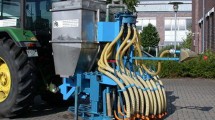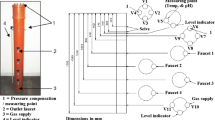Abstract
Three experiments were conducted using a system of small wind tunnels to measure ammonia (NH3) volatilization from cattle slurry after surface application to land. In each experiment slurry was applied at a rate equivalent to 80 m3 ha-1, providing the equivalent of approximately 100 kg NH4 +-N ha-1. The first experiment compared NH3 volatilization from the liquid fraction obtained by mechanical separation of slurry with that from unseparated slurry. The total NH3 loss over six days from unseparated and separated slurry were very similar, being 38 and 35% respectively of the NH4 +-N applied. For the first five hours, the rate of NH3 loss was higher from the unseparated slurry, thereafter it was consistently lower. In the second experiment, slurry was ponded in a tray to examine whether impeded infiltration or changes in the NH4 + concentration or overall pH of the slurry influenced the rapid decline in rate soon after application that is characteristic of NH3 volatilization from animal slurries applied to land. It appeared, however, that other factors such as resistance to diffusion within the slurry and/or at the slurry surface were mostly responsible for the rapid decline in rate. In the third experiment, in which NH3 volatilization was measured from slurry applied to grassland or bare soil, the total loss from slurry applied to grassland was approximately 1.5 times that from slurry applied to bare soil.
Similar content being viewed by others
References
Amberger A, Huber J and Rank M 1987 Gulleausbringung: Vorsicht, Ammoniakerverluste. DLG-Miteilungen. 20, 1084–1086.
ApSimon H M, Kruse M and Bell J N B 1987 Ammonia emissions and their role in acid deposition. Atmos. Environ. 21, 1939–1946.
Beauchamp E G, Kidd G E and Thurtell G 1982 Ammonia volatilization from liquid dairy cattle manure in the field. Can. J. Soil Sci. 62, 11–19.
Brunke R, Alvo P, Schuepp P and Gordon R 1988 Effect of meteorological parameters on ammonia loss from manure in the field. J. Env. Qual. 17, 431–436.
Cai G C, Freney J R, Humphreys E, Denmead O T, Samson M and Simpson J R 1988 Use of surface films to reduce ammonia volatilization from flooded rice fields. Aust. J. Agric. Res. 39, 177–186.
Denmead O T, Freney J R and Simpson J R 1982 Dynamics of ammonia volatilization during furrow irrigation of maize. Soil Sci. Soc. Am. J. 46, 149–155.
Dohler H and Weichmann M 1988 Ammonia volatilization from liquid manure after application in the field. In Agricultural Waste Management and Environmental Protection, Vol. 2. Eds. E Welte and I Szabolcs. pp 305–313. Proceedings of the 4th International Symposium of Scientific Centre of Fertilizers (CIEC), 11–14 May 1987, Braunschweig, FRG. Goltze-Druck Publishers, Gottenheim, FRG.
Freney J R, Simpson J R and Denmead O T 1983 Volatilization of ammonia. In Gaseous Loss of Nitrogen from Plant-Soil Systems. Eds. J R Freney and J R Simpson. pp 1–32. Martinus Nijhoff/Dr W Junk Publishers, The Hague, The Netherlands.
Gehrke C W, Kaiser F E and Ussary J P 1968 Automated spectrophotometric methods for nitrogen in fertilizers. J. Assoc. Off. Agric. Chem. 51, 200–211.
Heck A F 1931 The availability of the nitrogen in farm manure under field conditions. Soil Sci. 31, 467–481.
Jarvis M G, Hazelden J and Mackay D 1979 Soils of Berkshire: Soil Survey of England and Wales. Harpenden, UK.
Lockyer D R 1984 A system for the measurement in the field of losses of ammonia through volatilization. J. Sci. Food Agric. 35, 837–848.
Lockyer D R, Pain B F and Klarenbeek J R 1989 Ammonia emissions from cattle, pig and poultry wastes applied to pasture. Environ. Poll. 56, 19–30.
Long F N J 1988 Factors affecting the utilisation of nitrogen from cattle slurry applied to grassland. In Proceedings of British Grassland Society 1988 Research Meeting. 13–15 September 1988, Aberystwyth, UK. British Grassland Society, Hurley, UK.
Nihlgard B 1985 The ammonium hypothesis — an additional hypothesis to the forest dieback in Europe. Ambio 14, 2–8.
Pain B F and Hepherd R Q 1981 Benefits of dairy cow waste management systems based on mechanical separation. In Livestock Waste: A Renewable Resource. pp 422–425. Proceedings of the Second International Symposium on Livestock, Waste. American Society of Agricultural Engineers, St. Joseph, MI.
Pain B F, Hepherd R Q and Pittman R J 1978 Factors affecting the performance of four slurry separating machines. J. Agric. Eng. Res. 23, 231–242.
Pain B F, Phillips V R, Clarkson C R and Klarenbeek J V 1989 Loss of nitrogen through ammonia volatilization during and following the application of pig or cattle slurry to grassland. J. Sci. Food Agric. 47, 1–12.
Prins W H and Snijders P J M 1987 Negative effects of animal manure on grassland due to surface spreading and injection. In Animal Manure on Grassland and Fodder Crops. Fertilizer or Waste? Eds H G van der Meer, R J Unwin, T A van Dijk and G C Ennik. pp 119–135. Martinus Nijhoff Publishers, Dordrecht, The Netherlands.
Roelofs J G M, Boxman A W and Van Dijk H F G 1987 Effects of airborne ammonium on natural vegetation and forests. In Ammonia and Acidification. Eds. W Asman and S Diederen. pp 166–276. Proceedings of EURASAP Symposium, 13–15 April 1987, Bilthoven, The Netherlands. National Institute of Public Health and Environmental Hygiene (RIVM), Bilthoven, The Netherlands.
Stevens R J and Logan H J 1987 Determination of the volatilization of ammonia from surface-applied cattle slurry by the micrometeorological mass balance method. J. Agric. Sci. (Cambridge) 109, 205–207.
Thompson R B, Ryden J C and Lockyer D R 1987 Fate of nitrogen in cattle slurry following surface application or injection to grassland. J. Soil Sci. 38, 689–700.
Van Breemen N, Burrough P A, Velthorst E J, VanDobben H F, de Wit T, Ridder T B and Reijders H F R 1982 Soil acidification from atmospheric ammonium sulphate in forest canopy throughfall. Nature 299, 548–550.
Van Breemen N, Mulder J and Van Grinsven J J M 1987 Impacts of acid atmospheric deposition on woodland soils in the Netherlands. II. Nitrogen transformations. Soil Sci. Soc. Am. J. 51, 1634–1640.
Van der Molen J, Van Faassen H G, Vertregt N, Bussink W and Den Boer D J 1989 Ammonia emissions from arable and grassland soils. In Nitrogen in Organic Wastes Applied to Soil. Eds J Aa Hansen and K Hendricksen. pp 185–201. Academic Press, London.
Weatherburn M W 1967 Phenol-hypochlorite reaction for the determination of ammonia. Anal. Chem. 39, 971–974.
Author information
Authors and Affiliations
Rights and permissions
About this article
Cite this article
Thompson, R.B., Pain, B.F. & Lockyer, D.R. Ammonia volatilization from cattle slurry following surface application to grassland. Plant Soil 125, 109–117 (1990). https://doi.org/10.1007/BF00010750
Received:
Issue Date:
DOI: https://doi.org/10.1007/BF00010750




